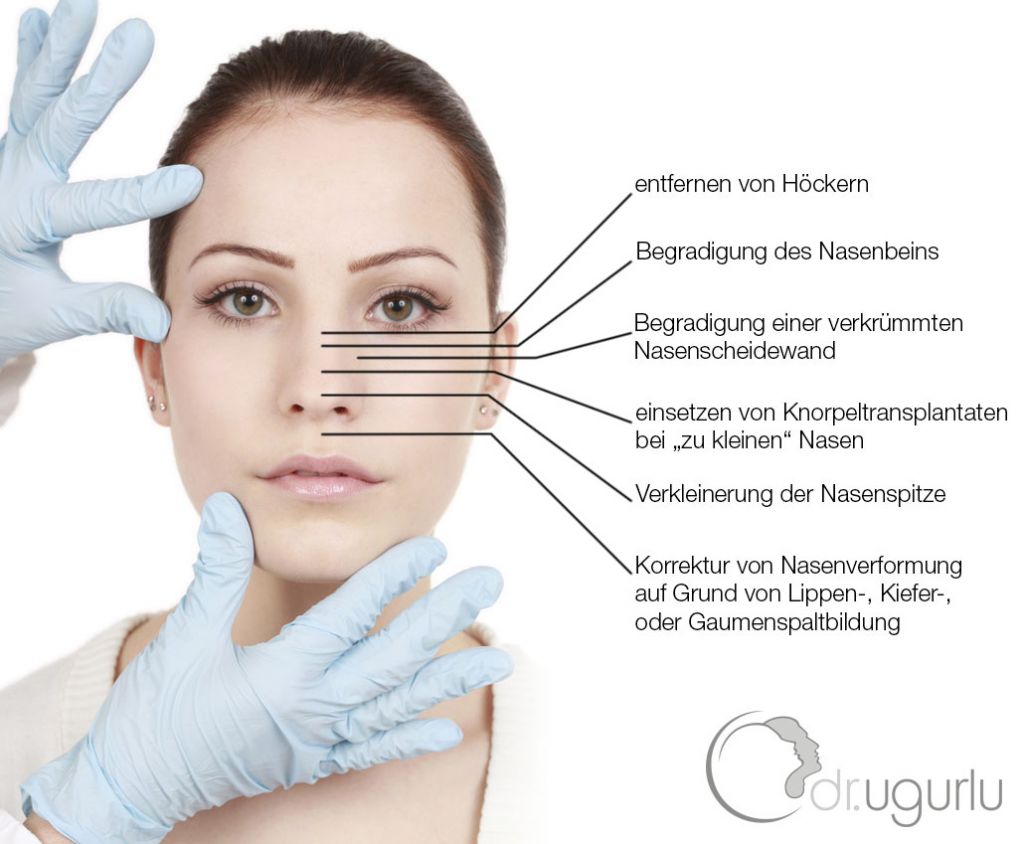With a given indication for surgery, there are various possibilities and techniques for rhinoplasty.
The nose must always be viewed holistically. Before an upcoming aesthetic rhinoplasty, all functions must be checked. A rhinoplasty should always take into account and treat the functions of the nose.
An aesthetic rhinoplasty changes the position and relationship of cartilage and bone inside the nose. Sometimes it is necessary to reduce these structures, in some cases cartilage and bone tissue must be increased.
A beautiful nose should be aesthetically pleasing from every angle (frontal, lateral, from below or from above) and should be planned to fit each individual face. A beautiful nose is only beautiful as long as it matches the corresponding face.
An aesthetic nose operation should be performed in accordance with the patient’s face shape and bone structure, in a manner appropriate to the patient’s realistic expectations. Without exception, a better appearance should take function into account and improve it if necessary.
Performance of rhinoplasty by Dr. Ugurlu in Hamburg
A nose correction (rhinoplasty) can technically be performed in two ways.
In aesthetic facial surgery, a distinction is made between open rhinoplasty and closed rhinoplasty.
In closed rhinoplasty, the surgeon accesses the nasal cartilage via the nasal entrances in order to reshape it. The procedure via the nasal entrances leaves no visible scars for the patient.
However, not every nose correction can be performed using the closed method if the correction is complex. In addition, the surgeon can better assess the structure during open rhinoplasty and make the necessary changes much more precisely.
With open rhinoplasty, an external incision is made between the nasal entrances to provide a better view of the entire surgical area and correct malformations of the nose, which would not be possible with an operation through the nasal entrances alone.
When the incision is made at the bridge of the nose, the skin of the nose is then opened so that the nose can be corrected. First, the septum is corrected if necessary and the nasal conchae are reduced in size to restore the functionality of the nose. Next, your doctor will reshape the tip of the nose and create the desired shape by removing the nasal hump. The nasal pyramid will then be made narrower by cutting through the bones and pushing the nasal bones together. Finally, the accesses are sutured using self-dissolving sutures. The scar resulting from the nose correction is minimal to barely visible and is located below the nose, which heals quickly. If the nasal septum has also been straightened, thin silicone films are inserted to stabilize and support the wound healing. Dr. Ugurlu performs the nose surgery without tamponades.
Both operations are performed under general anaesthesia and take 1-2 hours depending on the severity of the operation. The rhinoplasty is performed as an outpatient procedure, so that you can go home afterwards.
Aftercare of the rhinoplasty
Medication and care instructions for postoperative aftercare are provided in advance with a prescription. On the day of the operation you should cool your face and neck, e.g. with a gel pad. In the first days after a nose correction, cooling around the eye and cheek area can be helpful to avoid swelling and bruising and to reduce existing swelling more quickly.
If a nose plaster was used, please make sure not to soften it. Washing the hair should therefore be avoided in the first week after the operation. Lukewarm showering (without hair washing) is possible from the 3rd day after the operation. Furthermore, you should sleep with your upper body elevated by about 30 degrees. During the first three days after a nose correction, avoid dry, very firm, hot and strongly spiced food to avoid any irritation of the nose. Above all, the patient should drink sufficient and regular amounts of water after the operation to balance the body’s water balance and accelerate the healing process. In addition, there is a ban on smoking and alcohol in the first weeks after the operation.
In the first week after the nose correction, control appointments follow, in which on the one hand the silicone foils are removed and on the other hand the plaster is usually removed after a week. After removal of the plaster, the nose is treated with a tape bandage, usually for another week.
In order to support the healing process of the nose, you should not engage in excessive physical activity for 3 weeks after the operation.
In order to support the healing process of the nose, you should not take excessive physical exercise 3 weeks after the operation, and you should also avoid sauna and steam bath visits during this time. As the skin of the nose is very sensitive to sunlight after the operation, avoid extensive sunbathing in the first 8 weeks and protect the skin with a high sun protection factor (SPF 30). After some nose corrections you should avoid wearing glasses or sunglasses for the first 6 weeks. Instead, you should wear contact lenses or light glasses during this period.
Dr. Ugurlu designs an individual plan for each patient’s nose surgery. The patient’s wishes, a natural appearance and the gentlest possible surgical procedure with the least chance of revision are taken into account.
Your personal consultation with Dr.Ugurlu
If you would like to change the shape of your nose and/or improve your nasal breathing, Dr. Ugurlu is at your disposal for a detailed consultation. Make an appointment online right away.







